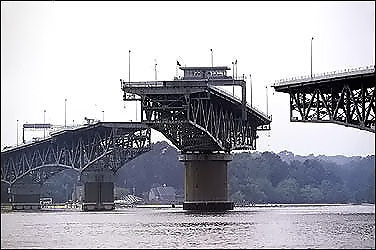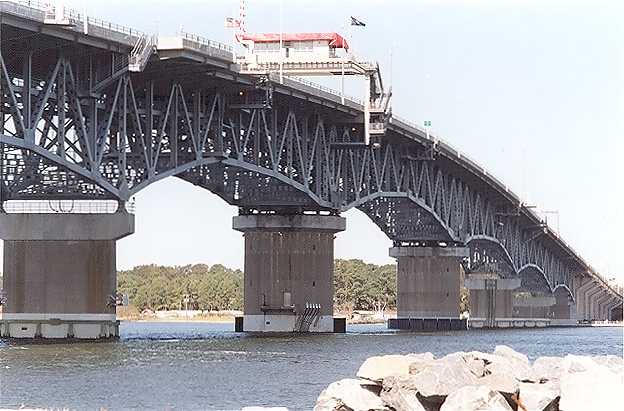
| George P. Coleman Bridge |
The George P. Coleman Bridge is a 3,750-foot-long double-swing-span bridge located in Yorktown, Virginia, and the bridge crosses the York River.
The Coleman Bridge was built as a 2-lane facility in 1952, and it connects the counties of York and Gloucester. The bridge carries Route US-17, a 4-lane arterial highway through eastern Virginia. George P. Coleman, the bridge's namesake, was the Commissioner (agency head) of the Virginia Department of Highways, from 1913 to 1922.
Due to increasing traffic that had caused the 2-lane bridge to be congested during peak hours, the bridge was widened and reconstructed to 4 lanes, with construction spanning from August 1994 to August 1996. The prime design consultant for the project was Parsons Brinckerhoff, and the prime construction contractor for the project was Tidewater Construction Corporation, of Norfolk, Virginia (now Tidewater Skanska, Inc.).
The Coleman Bridge main span has 450 feet of horizontal navigational clearance, and 60 feet of vertical navigational clearance when the movable spans are closed. When the movable spans are opened, there is unlimited vertical navigational clearance. The York River has a natural depth of over 60 feet where the bridge's movable spans are. The movable span is needed to allow ship access to several military installations that are upstream of the bridge. The roadways are almost 90 feet above the river at the highest point of the bridge.

Above, reconstructed Coleman Bridge, testing the
swingspan just prior to opening the bridge to traffic, photo by Virginia Department
of Transportation (VDOT). VDOT owns the bridge and administered the project to
reconstruct the bridge, and the project to build the original bridge.

The east side of the Coleman Bridge, photo taken from the south shoreline of the
York River, in October 2003 by Scott Kozel.
This $75 million reconstruction project used some very unique building techniques, not to mention the fact that the bridge is a fairly unique design in and of itself. Here is a list of websites that talk about the replacement project.
George P. Coleman Bridge Reconstruction Project In Yorktown, Va., from
Virginia Tech (VPI&SU) Construction Corner web
page. This article has six photos plus diagrams of the construction, plus historical
information. Excerpts (blue text):
The Coleman Bridge project
is a definitive model for future bridge reconstruction. In fact, this is the first
known project in the United States where a bridge of this size has been floated
in on barges, essentially ready for traffic (Spieldenner, 1996). The cooperation
and effort put forth by VDOT and TCC has provided a sensible and economic solution
while still trying to minimize delays for commuters.
Original Design Considerations - Initial design considerations in 1939 dealt with providing naval vessels access to an upriver refueling station. After WWII, and the disaster at Pearl Harbor, the Navy decided against bringing all their ships into one central location, and reduced their requirements for a navigational channel. The final requirements were a 450 ft. wide channel and 135 ft. vertical clearance. Another design consideration revolved around preserving the historic Yorktown area. Many historical organizations opposed any bridge which could be visible from the Yorktown battlefields. With these constraints, including a budget, the only logical decision was a double swing-span bridge (Abrahams 1994).
Current Design Considerations - many of the original design considerations had to be kept for the new bridge. The Navy still needed access to the Naval Weapons Station upstream, and the community and historical societies still wanted to preserve the beauty of the Yorktown area. Funding was another constraint as the issue of instituting tolls was debated between local residents and VDOT. At one time, there were seven design considerations, ranging from building a tunnel, to building a whole new bridge further upstream to help ease the current congestion. The final decision, however, was made to widen the existing bridge to four lanes--a move which proved to be the least expensive of all the options.
The two center swing spans are 500 foot long cantilevered trusses, while the remaining portions are plate girder spans varying in height from 27 to 40 feet. The substructure contains six river piers, the longest of which is 100 ft. deep, that are founded on hollow caissons which spread loads across the soft marl of the riverbed.
"What's new at VDOT - May 18, 1996 Virginia pioneers new bridge building technique".
Official VDOT web page (no longer linked) with brief article. Excerpt (blue text):
Coleman Bridge Replacement
Project, by A. Darryl Davis, Dean of the School of Industry and Technology,
East Carolina University, Greenville, N.C., who wrote the web page with construction
photos. Excerpt (blue text):
George P. Coleman Bridge, Yorktown, Virginia, by Parsons Brinckerhoff; a webpage with 9 computer-visualized aerial photos of the construction staging.
Replacement of the George P. Coleman Bridge, discussion of the design, by
Parsons Brinckerhoff. Excerpt (blue text):
Peterson Beckner Industries, Inc. has a page with one aerial photo of a pre-fabricated bridge section at the Norfolk International Terminal, Norfolk, Virginia.
Federal Highway Administration (FHWA) webpage section
Coleman Bridge Replacement Is Engineering First
with a photo of a span of the Coleman Bridge being floated into place. Excerpt
(blue text):
When the spans of the George
P. Coleman Bridge, which crosses the York River at Yorktown, Va., and which is
the second largest double-swing span bridge in the world, were replaced in May,
it was an engineering first. For the first time, a bridge was floated in with
everything needed to carry traffic, including roadway and lightpoles. 'Floating
in bridges is nothing new, but usually it is just the steel superstructure,' said
Jim Cleveland, district administrator for the Virginia Department of Transportation.
'The roadway, lightpoles, and other details are added later. Sometimes it takes
several months until the bridge can carry traffic. The Coleman Bridge [had] cars
driving across in just 12 days.' The new bridge is three times wider than the
original bridge and will have four lanes and 3-meter safety shoulders.
Details of Bridge Design and Inspection
Projects, from AIA & Associates, Inc. Quote (blue text):
Averting A Commuting Headache - Ferry service expected
to be in place for College commuters when Coleman Bridge closes,
by Poul E. Olson, of the
College of William and Mary. Excerpt (blue
text):
It's a commuting headache that's
been anticipated for at least four years. But the two-week closure of the Coleman
Bridge scheduled for May 3 probably won't cause as much stress for William and
Mary personnel as originally expected. A group of College and Virginia Institute
of Marine Science employees have reached a tentative agreement with the U.S. Coast
Guard to run a temporary ferry shuttle between its Yorktown training facility
and the ferry pier at VIMS. Use of the ferry would be limited to faculty, staff
and students of the College and U.S. Coast Guard personnel.
Tarmac Ready Mix, discussion about their work at the site where the pre-fabricated bridge sections were being constructed 45 miles from the bridge itself.
George P. Coleman Memorial Bridge, by
Controlled Demolition, Inc.
Webpage has an article about the demolition of the old sections of the Coleman
Bridge, with a photo. Excerpt (blue text):
Tidewater Construction Corporation's
replacement of the 4,000 ton, George P. Coleman Bridge in Norfolk, Virginia was
planned with Controlled Demolition Incorporated's input, from the beginning of
the project. The 2,600 foot long, 4 lane wide spans were floated from their original
location to rest on temporary piers designed for later removal with the assistance
of Controlled Demolition Incorporated. Using its DREXS (Directional Remote Explosive
Severance) System, Controlled Demolition Incorporated segmented the spans into
300 ton sections which matched the lifting capabilities of Tidewater's equipment.
The heavily reinforced concrete pier caps and caissons were subsequently segmented
by Controlled Demolition Incorporated to facilitate their removal.
George
P. Coleman Bridge Replacement, by U.S. Department of Transportation. Excerpt
(blue text):
Winner of the 1997 Grand Conceptor
Award of the American Consulting Engineers Council, the 77-foot-wide replacement
bridge sits on its original caissons, has four 12-foot traffic lanes, 10-foot
breakdown lanes, and features a state-of-the-art toll collection system. The double-swing
span permits the passage of ships while maintaining a low profile in deference
to neighboring Colonial National Historical Park (the site of the last major battle
of the Revolutionary War.
Coleman Bridge,
by York County, Virginia. Quote (blue text):
The George P. Coleman Bridge
was dedicated and opened on May 7, 1952. This bridge crosses the York River connecting
Yorktown and Gloucester Point. It is the world's largest double swing-span bridge,
and its original cost was in excess of nine million dollars.
Another
Coleman Bridge photo,
by York County, Virginia.
Virginia Toll Facilities
- George P. Coleman Bridge (Route 17), on the
VDOT website.
This one-mile bridge carries Rt. 17 traffic over the York River between historic
Yorktown and Gloucester County. The tolls listed below are collected in the northbound
direction only.
| Commuters (Smart Tag required) | 50¢ |
| Two-axle vehicles | $2 |
| Three-axle vehicles | 3 |
| Four- or more-axle vehicles | $4 |
Motorists in two-axle vehicles can qualify for the commuter rate by enrolling in the
Smart Tag program and making three trips across the bridge in 90 days. Smart Tag is an automated toll collection system that allows motorists to pay tolls without stopping at the toll booths.The following photos were taken in October 2003 by Scott Kozel.
 |
Coleman Bridge, east side of the bridge, photo taken from the north shore. |
 |
Coleman Bridge, east side of the bridge, photo taken from the south shore. |
 |
Coleman Bridge, east side of the bridge, photo taken from the south shore, closer to the bridge than the previous photo. |
 |
Coleman Bridge, east side of the bridge, photo taken from the south shore. Previous three photos were taken with a regular lens (50mm or 1.0x), and this photo was taken with a telephoto lens (100mm or 2.0x). |
 |
Northbound on US-17, in York County, approaching the south end of the Coleman Bridge. |
 |
Northbound on US-17, approaching the highest point of the Coleman Bridge. The overhead truss structure supports the control building where the drawbridge control panels and personnel are located. |
 |
Northbound on US-17, heading downgrade just after passing the highest point of the Coleman Bridge. Landfall in Gloucester County is in the distance. |
 |
Northbound on US-17, just after passing the north end of the Coleman Bridge. The toll plaza is ahead. Tolls are collected only in the northbound direction. The inner two lanes are reserved for Smart Tag electronic toll collection (ETC) customers only, and such vehicles can travel (without stopping) through the lane at up to a 35 mph speed limit. |
Copyright © 1998-2004 by Scott Kozel. All rights reserved. Reproduction, reuse, or distribution without permission is prohibited.
By Scott M. Kozel, Roads to the Future
(Created 12-25-1998, last update 6-5-2004)